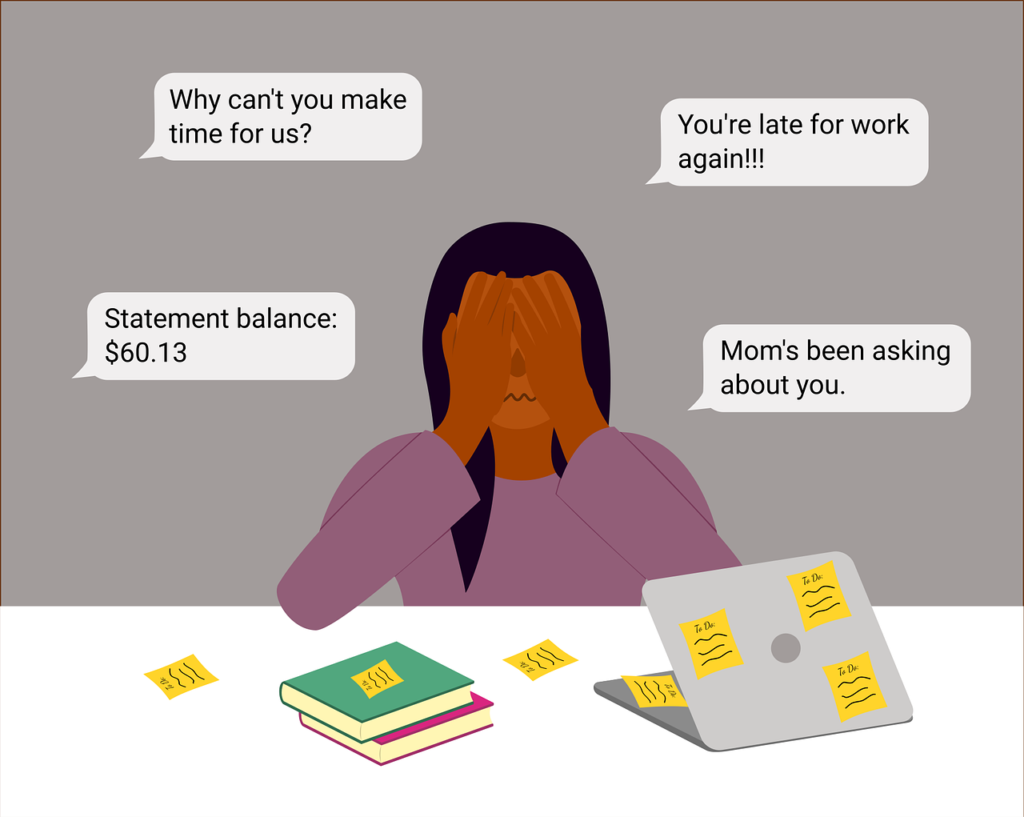It is estimated by the WHO that over 264 million adults around the world have anxiety (World Health Organization, 2017)
That is a huge number. Wouldn’t you agree?
Anxiety is your body’s response to fear and worry and people experience this to varying degrees.
Are you someone who struggles with constant anxious thought biases?
If so, this might affect how you show up in life and can even have a tremendous impact on your quality of life.
Dr. Julie Smith, in her book: Why Has Nobody Told Me This Before? Says that there are a few thought biases that commonly occur when we are feeling anxious.
Being cognizant of these biases will help you scrutinize your anxious thoughts better.
You will then decide whether to accept them as absolute truths, or just observe them as passing clouds in your mind that you don’t have to read into.
In this blog, I will discuss five of these anxious thought biases listed below, and how you can handle them when they arise.
- Catastrophizing
- Personalizing
- Mental filter
- Overgeneralizing
- Labelling

1. Catastrophizing
To me, catastrophizing is like playing a horror movie constantly in your mind – not to be dramatic.
It is when your mind jumps to the extreme worst-case scenario when you are presented with threatening information.
Imagine you have missed work for two days because of ill health.
When you do get back to work – your boss casually tells you in passing that he would love to have a chat with you; in fifteen minutes.
Even though you informed everyone that you were feeling a bit indisposed, and wouldn’t be able to make it to work, this is the kind of thought your mind is likely to conjure up: ‘He is going to tell me that I will not hit my quarterly targets if I continue to miss work and I will most likely get fired.’
Sounds extreme right?
Because our minds are wired to look for ways to keep us safe, we end up thinking of the worst-case scenarios to be better prepared when they happen.
But let’s be honest, how often do these extreme situations occur?
Maybe your boss wanted to welcome you back, ask how you are doing, and bring you up to speed on what’s going on.
2. Personalization
This is when you have some limited or ambiguous information about the world and make it about yourself.
For example, you are walking down the stairs – you say hi! to your partner who is watching TV and she replies with a nonchalant hi.
Your personalizing thoughts will tell you that: ‘ She is falling out of love with me, she doesn’t want to engage in any conversation with me, she is cheating.’ Wow! Hold your horses cowboy!
Maybe she has just gotten some upsetting news or, maybe she is not feeling well at that moment.
This personalizing bias demands your attention because it’s threat-focused.
If my partner has fallen out of love with me, this is something I need to focus on and be ready for any consequences that ensue.
To be honest, this is an anxiety thought bias that I personally have struggled with. But we are all human and we continue to do the work.
On to the next….
3. Mental filter
This is the tendency to hold on to the information that makes you feel worse and neglect all the information that could help you feel differently.
If you are a fearful and worrisome person, you will look out for information that validates these fears and worries about a certain matter that you already felt insecure about.
For example, let’s say you publish a blog and get about 50 comments on it. 47 of the comments are positive and only 3 are negative.
If you are worried that your content is not good enough and are insecure about it, your mind is going to choose to focus on the negative comments; ignoring the 47 people that took time out to comment and appreciate your work.
Does that even make sense? No! and yet, that’s how most of us think.
But don’t worry, it’s not you, the brain naturally wants to focus on threatening information because its job is to keep us safe.
4. Overgeneralizing
This is when you take one experience and apply it to all experiences.
For example, say you go for a job interview, and you know you nailed it!
You later get an email that reads: ‘We regret to inform you that we decided to go in a different direction, and we’ll not be able to take you on at this time.’
This is obviously a disheartening situation.
Your overgeneralizing thoughts might sound like, ‘I’m never getting a job, so what’s the point of submitting any other applications?’
You need to watch out for overgeneralizing because it leads to a more intense spike of emotion and makes anxiety worse.
5. Labelling
This is similar to overgeneralizing but involves taking one event or period of time and using that to make global judgments about who you are as a person.
For example, say you dated someone at a particular time in your life that had no regard for your feelings; they would constantly talk to other people inappropriately and didn’t give you any attention.
Having to fight for their love and attention made you feel like you were a clingy and jealous person.
Honey, that isn’t you. You were just in the wrong relationship.
Each emotion, behavior, and period in your life is temporary and not necessarily a reflection of who you are permanently.

So, the good part………
Before I continue, I want to remind you that your thoughts are not factual. They are just suggestions, guesses, and theories.
The power of any thought lies in whether you accept it to be a true reflection of reality.
Here are five things you can do to manage these thought biases.
1. Create some distance between you and your thoughts
The best way to break down the power that thoughts have over our emotional state is to first get some distance from them.
You can do this by using distanced language. This helps to turn down the dial on the emotion.
Instead of saying ‘I’m going to fail this job interview.’ Say, I’m having thoughts about failing this job interview.
Talking like this might seem weird at first.
But the more you practice re-phrasing your thoughts this way, you will realize that you are not your thoughts; you are the one observing them, and you can choose whether to accept them as true or not.
Another way to create distance from your anxious thoughts is by journaling.
When you jot down whatever thoughts you are having on paper, it helps you look at them from a different vantage point and helps you gain a new perspective on your emotional state.
2. Compassionate self-talk
When you are in the thick of it; things are not working out, and your anxious thoughts are eating away at you, imagine what a loving parent, friend, or partner would tell you in that instance.
When I’m overgeneralizing or catastrophizing, I love to look in the mirror and talk to myself in a compassionate way.
I tell myself that everything will be okay, that I will find a solution for whatever challenge I’m facing, and that nothing is permanent.
This helps to reduce the tension in my body and sends signals to my brain that I’m safe.
The threat response of flight, freeze, or fight is then turned down and my anxiety simmers down.
3. Reframing
Now, this is truly magical!
When I first signed up for driving lessons a couple of years back, I was very anxious.
I had all kinds of thoughts in my mind like, ‘what if I knock someone?’ ‘What if I get into an accident?’
When my mother would ask ‘how are you feeling?’ I would say, ‘I’m worried and scared that something will go wrong.’
She would then say, ‘ but what if you enjoy the lessons and have fun?’
This made me realize that instead of being anxious and fearful, all I had to do was tell myself that I’m excited to gain the convenience of driving myself anywhere I wanted to go.
Funny story: I used to be anxious about first dates. Sometimes I would end up canceling or postponing them until I felt ready.
Now, when I have a date planned, instead of telling myself it’s going to be awkward and weird, I tell myself: ‘what a great opportunity to meet someone and hear all about their interests and take on life!’
Reframing anxious thoughts into something positive makes a world of difference.
Conclusion
It’s my hope that once you’ve learned about these anxious thought biases, you will start to scrutinize your thoughts and not buy into each one of them as the absolute truth.
Have you been practicing any of the methods I have described in the article to manage your anxious thought biases?
If so, please let me know your experience in the comments.

- Hey there! Welcome to thehealseekers, a space created to expand women's consciousness in metaphysics, psychology, and self-development. I hope you find inspiration here!
Latest Post
 PsychologyNovember 25, 2025The Mind Only Resists Starting — And Why That Changes Everything
PsychologyNovember 25, 2025The Mind Only Resists Starting — And Why That Changes Everything Self-developmentNovember 25, 2025Self-Mastery: The Silent Power Behind Every Success
Self-developmentNovember 25, 2025Self-Mastery: The Silent Power Behind Every Success MetaphysicsNovember 22, 2025When everyone is right in their own world – what does truth really mean?
MetaphysicsNovember 22, 2025When everyone is right in their own world – what does truth really mean? Self-developmentNovember 21, 2025This Is Just a Blip – Why Your Current Struggles Are Just a Season, Not a Sentence
Self-developmentNovember 21, 2025This Is Just a Blip – Why Your Current Struggles Are Just a Season, Not a Sentence

Omgggg Cynthia this is insightful as always. Thank you very much for sharing. Very much appreciated 😍
Thank you too for leaving a comment. It is much appreciated.
It’s a very good and educative article, I have learnt how to go on with my life in a good way. I pray God may give me the grace to follow all you have taught.
I am glad to know that you will be incorporating these methods into your life.
Am humbled for what am seeing you doing. Am really proud of you. Your article s are so good and educative. Keep it up.
Wow! thank you so much for the comment. I appreciate it.